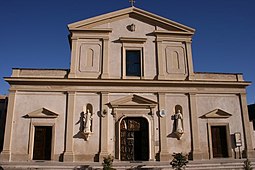
The Archdiocese of Capua is a Latin diocese of the Catholic Church in Capua, in Campania, Italy, but its archbishop no longer holds metropolitan rank and has no ecclesiastical province. Since 1979, it is a suffragan of the Archdiocese of Napoli, i.e. no longer has its own ecclesiastical province nor metropolitan status.

The Archdiocese of Otranto is a Latin archdiocese of the Catholic Church in Italy. The seat of the diocese is at Otranto Cathedral in the city of Otranto, Apulia. It is a suffragan of the archdiocese of Lecce.

The Archdiocese of Manfredonia–Vieste–San Giovanni Rotondo is a Latin Church non-Metropolitan Archdiocese of the Catholic Church in the civil province of Foggia, in Apulia, south-eastern Italy, which is part the ecclesiastical province of the Metropolitan Archdiocese of Foggia-Bovino
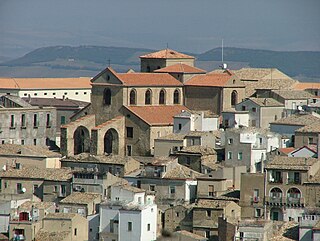
The Diocese of Tricarico is a Latin diocese of the Catholic Church in Basilicata. It is a suffragan of the Archdiocese of Potenza-Muro Lucano-Marsico Nuovo.

The Archdiocese of Reggio Calabria-Bova is a Latin Church ecclesiastical territory or diocese of the Catholic Church in Calabria, southern Italy. It received its current title in 1986, when the independent Diocese of Bova was suppressed, and the territory and title of the diocese added to that of the Archdiocese of Reggio.

The Diocese of Cassano all'Jonio is a Latin diocese of the Catholic Church in Calabria.

The Diocese of Nocera Umbra was a Catholic diocese in Umbria, Italy.

The Archdiocese of Lecce is a Latin Church ecclesiastical territory or archdiocese of the Catholic Church in Apulia, southern Italy. The diocese has existed since the 11th century. On 28 September 1960, in the bull Cum a nobis, Pope John XXIII separated the diocese of Lecce from the ecclesiastical province of Otranto and made it directly subject to the Holy See. In the bull Conferentia Episcopalis Apuliae issued on 20 October 1980, Pope John Paul II created the ecclesiastical province of Lecce, with the Archdiocese of Otranto becoming a suffragan diocese.

The Archdiocese of Crotone-Santa Severina is a Latin Church diocese of the Catholic Church in Calabria in southern Italy, created in 1986 when it was combined with the Diocese of Santa Severina. It is now a suffragan of the Archdiocese of Catanzaro-Squillace. In 2013 there was one priest for every 1,841 Catholics.
The Catholic diocese of Sarsina was a Roman Catholic ecclesiastical territory in Emilia-Romagna, northern Italy, seated in Sarsina, in the province of Forlì, some 32 km south-southwest of Cesena. The diocese was founded in the 5th century, and was suffragan (subordinate) to the archbishop of Ravenna. The diocese existed until 1986, when it was united with the diocese of Cesena.
The Italian Catholic diocese of Venosa, in southern Italy, existed until 1986. In that year it was united into the Diocese of Melfi-Rapolla-Venosa. From 1976 to 1986, Venosa had been a suffragan of the archdiocese of Potenza e Marsico Nuovo.
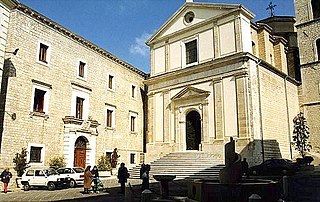
The Archdiocese of Potenza-Muro Lucano-Marsico Nuovo is a Latin diocese of the Catholic Church in Basilicata, southern Italy, created in 1986. In that year the Diocese of Muro Lucano was united into the Archdiocese of Potenza e Marsico Nuovo, which had been elevated to an archdiocese in 1973, and made a metropolitan see in 1976. The historical Diocese of Potenza was united with the Diocese of Marsico Nuovo in 1818.

The Diocese of San Severo is a Latin diocese of the Catholic Church in Apulia. It is a suffragan of the Archdiocese of Foggia-Bovino.
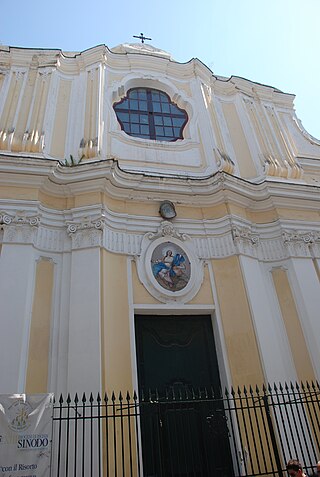
The Diocese of Ischia is a Latin diocese of the Catholic Church in Campania, southern Italy. It is a suffragan of the Archdiocese of Naples. The diocese comprises the entire island of Ischia, which contains seven communes divided into two circumscriptions. In 1743, the population was about 4,000. The city of Ischia constituted one single parish, with two religious houses of men and one of women. In 2018, the population of the town of Ischia was 20,118.

The Diocese of Ugento-Santa Maria di Leuca is a Latin diocese of the Catholic Church in Apulia, has existed under this name since 1959. It is a suffragan of the Archdiocese of Lecce. The historic Diocese of Ugento has existed since the thirteenth century.
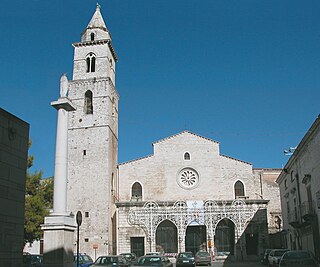
The Diocese of Andria is a Latin diocese of the Catholic Church in Apulia, seated at Andria Cathedral which is built over a church dedicated to St. Peter, about ten miles southwest of Trani. It is a suffragan of the archdiocese of Bari-Bitonto. The diocese has 39 parishes, with one priest for every 1,573 Catholics.

The Diocese of Castellaneta is a Latin diocese of the Catholic Church in Apulia. It is a suffragan of the Roman Catholic Archdiocese of Taranto.

The Archdiocese of Catanzaro-Squillace is a Latin Church diocese of the Catholic Church in Calabria, has existed in its current form since 1986. In that year the Archdiocese of Catanzaro became a metropolitan see, and was combined with the diocese of Squillace.
The Italian Catholic diocese of Lacedonia, a suffragan of the archdiocese of Benevento in Campania, existed until 1986 when incorporated into the reorganized Roman Catholic Diocese of Ariano Irpino-Lacedonia.
The Diocese of Montepeloso was a Roman Catholic diocese located in the town of Montepeloso in the province of Matera in the Southern Italian region of Basilicata. It was united with the Diocese of Gravina to form the Diocese of Gravina e Irsina (Montepeloso) in 1818. The name "Irsina" was given to the town of Montepeloso by vote of the council of the commune on 6 February 1895.
